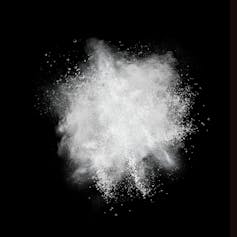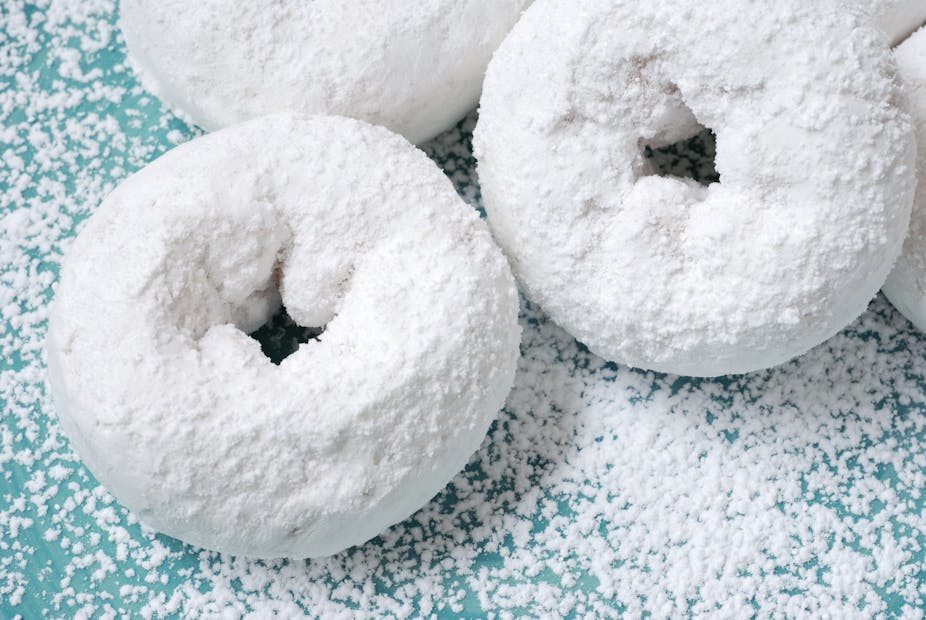In response to pressure from the advocacy group As You Sow, Dunkin’ Brands has announced that it will be removing allegedly “nano” titanium dioxide from Dunkin’ Donuts’ powdered sugar donuts. As You Sow claims there are safety concerns around the use of the material, while Dunkin’ Brands cites concerns over investor confidence. It’s a move that further confirms the food sector’s conservatism over adopting new technologies in the face of public uncertainty. But how justified is it based on what we know about the safety of nanoparticles?
Titanium dioxide (which isn’t the same thing as the metal titanium) is an inert, insoluble material that’s used as a whitener in everything from paper and paint to plastics. It’s the active ingredient in many mineral-based sunscreens. And as a pigment, is also used to make food products look more appealing.
Part of the appeal to food producers is that titanium dioxide is a pretty dull chemical. It doesn’t dissolve in water. It isn’t particularly reactive. It isn’t easily absorbed into the body from food. And it doesn’t seem to cause adverse health problems. It just seems to do what manufacturers want it to do – make food look better. It’s what makes the powdered sugar coating on donuts appear so dense and snow white. Titanium dioxide gives it a boost.
And you’ve probably been consuming it for years without knowing. In the US, the Food and Drug Administration allows food products to contain up to 1% food-grade titanium dioxide without the need to include it on the ingredient label. Help yourself to a slice of bread, a bar of chocolate, a spoonful of mayonnaise or a donut, and chances are you’ll be eating a small amount of the substance.
Why does As You Sow want this substance gone from Dunkin’ Donuts?
The answer in part comes from the little prefix “nano.”
For some years now, researchers have recognized that some powders become more toxic the smaller the individual particles are, and titanium dioxide is no exception. Pigment grade titanium dioxide – the stuff typically used in consumer products and food – contains particles around 200 nanometers in diameter, or around one five hundredth the width of a human hair. Inhale large quantities of these titanium dioxide particles (I’m thinking “can’t see your hand in front of your face” quantities), and your lungs would begin to feel it.

If the particles are smaller though, it takes much less material to cause the same effect. But you’d still need to inhale very large quantities of the material for it to be harmful. And while eating a powdered donut can certainly be messy, it’s highly unlikely that you’re going to end up stuck in a cloud of titanium dioxide-tinted powdered sugar coating!
This is the “nano” effect, where some particles smaller than 100 nanometers seem to be more “potent” – or capable of doing more damage in the body – than larger particles of the same material. It’s an effect that is particularly clear when particles like titanium dioxide deposit in the lungs. But it can also occur elsewhere in the body. Depending on what they are made of and what shape they are, research has shown that some nanoparticles are capable of getting to parts of the body that are inaccessible to larger particles. And some particles are more chemically reactive because of their small size. Some may cause unexpected harm simply because they are small enough to throw a nano-wrench into the nano-workings of your cells.
This body of research is why organizations like As You Sow have been advocating caution in using nanoparticles in products without appropriate testing – especially in food. But the science about nanoparticles isn’t as straightforward as it seems.
First of all, particles of the same size but made of different materials can behave in radically different ways. Assuming one type of nanoparticle is potentially harmful because of what another type does is the equivalent of avoiding apples because you’re allergic to oysters.

Food grade titanium dioxide is really common and not so “nano”
The titanium dioxide used by Dunkin’ Brands and many other food producers is not a new material, and it’s not really a “nanomaterial” either. Nanoparticles are typically smaller than 100 nanometers in diameter. Yet most of the particles in food grade titanium dioxide are larger than this. They have to be for the powder to be of any use in food products.
Admittedly food grade titanium dioxide does contain a few nanoparticles, and this shouldn’t be dismissed. A 2012 study out of Paul Westerhoff’s lab at Arizona State University tested 89 off-the-shelf food products for the presence of titanium dioxide. The list included everything from gum and soy milk, to Twinkies and mayonnaise. As well as finding evidence for the substance in every product, the research also indicated that up to 5% of the titanium dioxide in some of these products could be in the form of nanoparticles.

Yet there is little evidence that this small quantity of nanoparticles skews the safety of food grade titanium dioxide. In 2004 the European Food Safety Agency carried out a comprehensive safety review of the material. After considering the available evidence on the same materials that are currently being used in products like Dunkin’ Donuts, the review panel concluded that there no evidence for safety concerns.
Most research on titanium dioxide nanoparticles has been carried out on ones that are inhaled, not ones we eat. Yet nanoparticles in the gut are a very different proposition to those that are breathed in.
Studies into the impacts of ingested nanoparticles are still in their infancy, and more research is definitely needed. Early indications are that the gastrointestinal tract is pretty good at handling small quantities of these fine particles. This stands to reason given the naturally occurring nanoparticles we inadvertently eat every day, from charred foods and soil residue on veggies and salad, to more esoteric products such as clay-baked potatoes. There’s even evidence that nanoparticles occur naturally inside the gastrointestinal tract.
Could there be a risk from titanium dioxide that we don’t know about yet?
There’s a small possibility that we haven’t been looking in the right places when it comes to possible health issues. Maybe – just maybe – there could be long term health problems from this seemingly ubiquitous diet of small, insoluble particles that we just haven’t spotted yet. It’s the sort of question that scientists love to ask, because it opens up new avenues of research. It doesn’t mean that there is an issue, just that there is sufficient wiggle room in what we don’t know to ask interesting questions.
It’s questions like this that are driving current toxicology research on nanoparticles. While there is no evidence of a causal association between titanium dioxide in food and ill health, some studies – but not all by any means – suggest that large quantities of titanium dioxide nanoparticles can cause harm if they get to specific parts of the body.
For instance, there are a growing number of published studies that indicate nanometer sized titanium dioxide particles may cause DNA damage at high concentrations if they can get into cells. But while these studies demonstrate the potential for harm to occur, they lack information on how much material is needed, and under what conditions, for significant harm. And they tend to be associated with much larger quantities of material than anyone is likely to be ingesting on a regular basis.
They are also counterbalanced by studies that show no effects, indicating that there is still considerable uncertainty over the toxicity or otherwise of the material. It’s as if we’ve just discovered that paper can cause cuts, but we’re not sure yet whether this is a minor inconvenience or potentially life threatening. In the case of nanoscale titanium dioxide, it’s the classic case of “more research is needed.”
Uncertainties like this – small as they are – are magnified when the perceived gains are low, which is why Dunkin’ Brands is reformulating its donut coating. They claim to be able to recreate the same visual effect without the titanium dioxide. Other opacity additives are available, although in this case Dunkin’ Brands aren’t replacing the titanium dioxide with anything else. If substitutes are used however, there needs to be thorough safety testing if these alternative additives are to find favor.
And this gets to the crux of the issue raised by Dunkin’ Brands’ decision – when there’s uncertainty around the science, how can food companies make smart decisions that don’t come back to bite them, either in the board room or in the court of public opinion?

